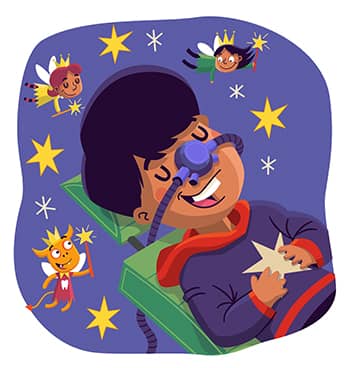Nitrous Oxide
Nitrous Oxide: Gentle Sedation for Pediatric Dentistry
Nitrous oxide, known as “laughing gas,” is a very safe, inexpensive means of mild sedation. When used in pediatric dentistry, it helps most children relax and sometimes even “laugh” through dental procedures.
Dentists have used nitrous oxide for over 100 years as a mild sedative and to relieve discomfort and anxiety. It is safe for use with children, especially for those who are anxious in the dental office.
Nitrous oxide is a colorless gas, with a very gentle effect. The child receives it in combination with oxygen via a disposable small soft mask over the nose. The child then breathes normally through the nose.
How Nitrous Oxide Works
 Nitrous oxide helps the child to feel relaxed, happy and comfortable within three minutes. It does not affect heart rate, and has no ill effects on the brain, lungs and kidneys. The low solubility in blood and other tissues makes nitrous oxide the fastest “in/out” anesthetic agent available.
Nitrous oxide helps the child to feel relaxed, happy and comfortable within three minutes. It does not affect heart rate, and has no ill effects on the brain, lungs and kidneys. The low solubility in blood and other tissues makes nitrous oxide the fastest “in/out” anesthetic agent available.
When the procedure is complete, the nitrous oxide is turned off. Breathing pure oxygen for about five minutes clears out any remaining nitrous oxide. The gas is quickly eliminated from the body. The euphoric effects go away in a few minutes, so there is little recovery time.
Nitrous oxide has limited side effects. The most common side effect of nitrous oxide is nausea and vomiting, which can be mostly avoided by carefully monitoring the child for early ill effects.
Dr. Sara Babich recommends not eating for two hours before the visit to help reduce nausea.
Scientific study
Recently, The European Society of Anesthesiology Task Force on Nitrous Oxide reviewed the role of nitrous oxide in clinical pediatric dental practice.
Their findings noted that “nitrous oxide can be efficiently used for procedural sedation in the pediatric population for a variety of procedures of light to moderate pain intensity.”* The Task Force concluded that “no major adverse effects have been reported with nitrous oxide administration.”
*Source: British Journal of Anaesthesia (volume 122, pages 587-604, 2019)
Pediatric Dentistry: Dr. Sara B. Babich, DDS
116 E 84th St
New York, NY 10028
(84th St. btw Park Ave / Lex Ave)
☎ 212-988-4070
 Contact us today to learn more about our
Contact us today to learn more about our New York City pediatric dentistry practice
 (212) 988-4070
(212) 988-4070